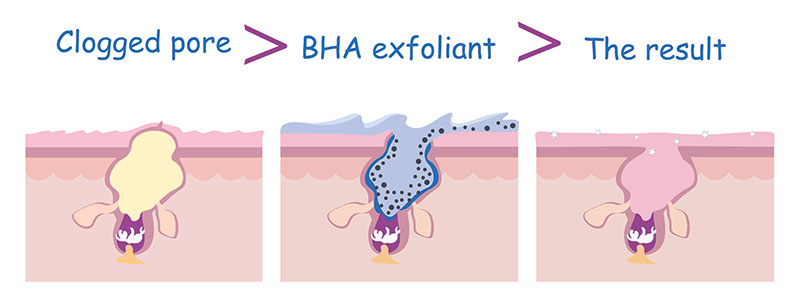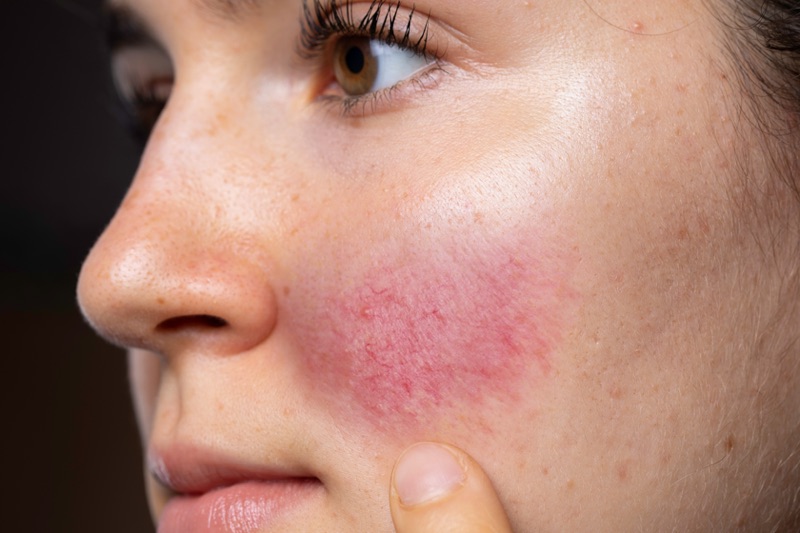Can you use Salicylic Acid and Retinol Together?
While both the active ingredients are hugely popular, the internet is split on whether you can use them together or not. Let’s clear up this confusion today.
Combining Salicylic Acid and Retinol together?
Both the ingredients are active and have an exfoliating tendency which makes them “Incompatible” together. The combination can lead to even more skin complications than you already have.
All our skin problems would have been solved if they had worked together but alas, both the ingredients are individually very strong and can rip the skin off. If you still want to incorporate the benefits from both ingredients, use Salicylic acid in the morning and Retinol in the nighttime to gain the benefits.
Salicylic Acid – Beta Hydroxy Acid!
This guy is dumped in literally every other product nowadays. It can be found over the counter and the reason for its popularity is, it’s a boon for oily skin and acne-prone skin.

- This FDA-approved beta hydroxy acid is oil soluble which is why it is ideal for oily skin and acne-prone skin types.
- It dissolves excess oil, dirt, and dead skin cells, unclogs pores, and cleanse the skin by going into a deeper layer.
- Salicylic Acid has an anti-inflammatory and mild anti-bacterial property which kills the bacteria which basically chews up on oil and calms the inflammation.
- Application of a Salicylic acid mask is the ideal and the most correct way of treating blackheads and whiteheads. Salicylic acid works by dissolving the keratin that clogs the pores causing blackheads.
- It works as a great exfoliating agent by reducing excess sebum production, keeping the skin’s oil production low and bacteria-free.
- It comes in different forms- Gels, Masks, Spot treatment, Face cleansers, and Toners.
- It is a much better and milder ingredient to be tolerated by our skin for acne compared to the other potent ingredients.

How to incorporate Salicylic acid correctly in your skincare routine?
- Do not mix salicylic acid with random active ingredients. It can react badly on the skin if not paired correctly. So, read on before mix-matching.
- Always do a patch test before applying it on your face directly for the first time. It may save you from loads of trouble.
- Start with a lower concentration of salicylic acid serum like 0.5%, then gradually when your skin feels ready, you can increase it up to 2%.
- Salicylic acid makes the skin photosensitive which means your skin becomes sensitive to UV rays of the sun so, don’t step out without Sunscreen.
- Avoid using it near your eyes, nose, and mouth. (Extra tip – layer the corners of your eyes, and mouth with Vaseline and then apply salicylic acid).
- You can also add Salicylic acid cleanser every day in your skincare routine. It’s a wash-off, and not a treatment, hence the cleanser form can be the safest way to start with.
Which ingredients are Salicylic Acid compatible with?
- Niacinamide
- Hyaluronic acid
- Vitamin C
Who should not use Salicylic Acid?
- Don’t use it if you’re pregnant or nursing.
- If you have fresh cuts, scrapes or rashes on the skin, please don’t use Salicylic acid on those.
Does Salicylic Acid have any side effects?
- Dryness
- Peeling skin
- Mild burning sensations
These could be a few side effects; you might have when either using it for the first time or using it incorrectly, but mostly it’s not severe.
How to cure skin side effects from Salicylic Acid?

- Avoid scented cleansers and moisturizers on the face.
- Avoid makeup for a while.
- Use Thermal spring water to calm the skin (Try from La Roche Posay)
- Take cold showers or ice your face (Wrapped in a thin cloth). Avoid hot showers completely.
- Don’t use any exfoliating fancy gadgets to wash your face, simply use your hands.
- Now give a lot of moisture and hydration to the skin for it to feel better. Like moisturizers loaded with Ceramides, Oatmeal, and Hyaluronic acid.
- After Moisturizer, seal the skin with Vaseline. It locks in all the goodies we have given & lets the skin heal faster.
- Stop using any other exfoliants, acids, AHAs, BHAs, Benzoyl peroxide, and Retinoids until you are completely healed.
- Cica Balms, Glycerin, and Aloe vera are great soothing and calming agents for the skin.
- Product suggestion- Try Avene- Cicalfate + restorative protective cream.
- DO NOT forget to wear sunscreen daily before stepping outside. Remember your skin is already in a vulnerable state. UV radiation at this point can make it worse.
History of Salicylic Acid
Salicylic acid has been used since ancient times when people used willow bark as a remedy for pain and fever. The bark of the wood contains salicin, which gets converted into Salicylic acid in the body. The book, “The History of Medicine: a very short introduction” by William Bynum proves and explores all the historical uses and benefits of willow bark.
In the late 19th Century, a German chemist named Felix Hoffmann, who was working in pharmaceutical company synthesized ASA, commonly known as aspirin. Aspirin was derived from Salicylic acid but was mild and hence much better tolerated by the stomach. Since then, Salicylic acid is used widely to treat skin concerns like acne, and to control excess oil and sebum production in the skin. It works as an excellent skin exfoliator as well and is one of the key ingredients in the skin care industry to treat a lot of skin concerns.
Retinol

Here comes this high gold standard guy of skincare industry, highlight of every skincare topic!
- As we all know, Retinol is a derivative of Vitamin A.
- It does not work just on the outer layer of the skin but goes deep into the dermis and exfoliates dead skin cells, regenerates fresh ones and This is what slows down the aging!
- It is found over the counter.
- Retinol comes from the family of retinoids & is 1 of the 7 kinds of retinoids.
What are the benefits of Retinol?
- Boosting Collagen production by speeding skin cell turnover rate to double.
- Treats mild-moderate acne and acne scars.
- Takes care of visible signs of premature skin aging issues like wrinkles, sagging skin, and fine lines.
- Works great for hyperpigmentation and discoloration problems.
How does Retinol work on the skin?
- When we start to age, our cells don’t regenerate as quickly as they did when we were young.
- Retinol directly affects gene expression, regulating all our age-related issues by eliminating dead skin cells and allowing fresh, new skin cells to come up to the surface.
- It goes deep into the layers of the skin and exfoliates the clogged pores from within. It also clears up acne by cleaning up the pores and eliminating bacterial growth.

What are any potential side effects of Retinol?

- Increases skin’s sensitivity towards UV light, hence always use sunblock in the daytime.
- Do not mix Retinol with any other ingredients without reading properly about it as it doesn’t gel up with most of the ingredients and causes reactions.
- Use it at some distance from your eyes, mouth, and nose as they’re sensitive areas.
- Always start with low concentration, like .025% – 0.1%.
- Do not exceed the quantity of more than a pea size. Too much does more harm than good.
What ingredients are Retinol compatible with?
Don’t mix Retinol with any other ingredient except – Niacinamide, Hyaluronic Acid, Azelaic Acid
Don’t use Retinol in your skincare routine under the following conditions
- If You’re Pregnant or Nursing
- If you have a sensitive skin type or skin conditions like Eczema and Rosacea. Retinol will make your dry skin worse.
History of Retinol
In the 1960s, a few researchers discovered that Vitamin A could be used to treat a variety of skin conditions like Psoriasis, Photoaging and Acne. In 1986, a clinical study was conducted on the effectiveness and safety of Retinol to treat photo aging and the authors described it as safe & effective.
Since then, Retinol has been one of the favorite ingredients of the skincare industry and you can find it in any variety of forms like creams, serums, and moisturizers. It’s a key tool in the fight against acne and aging signs. Also, a book published in 2014 called ” Vitamin A and Retinoids: An update of Biological and clinical applications” edited by M. Christina Meinardi, Manuela Nebbioso, and Maria A. Livrea covers all the roles of Retinoids in various biological processes, and their therapeutic uses in various diseases in the body.
Any Retinol shopping tips?

Conclusion- Salicylic acid and Retinol
Can you apply both Salicylic acid and Retinol together at the same time? The answer is No.
If you want to take the benefits of both ingredients, just apply them separately at different times of the day. Apply Salicylic acid in the morning and Retinol at night. If applied together they will over-exfoliate and rip off the skin.
References
https://www.ncbi.nlm.nih.gov/pmc/articles/PMC2699641/
https://www.ncbi.nlm.nih.gov/books/NBK519032/
A few related articles you may like
If you loved reading this article, you will probably also enjoy reading:
- Can you use Glycolic Acid with Retinol?
- Should you apply Retinol before or After Moisturizer
- Can you use Benzoyl Peroxide with Retinol?
- Can you use Azelaic Acid and Retinol Together
- Can you use Retinol And Hyaluronic Acid Together?
- Can you use Niacinamide with Retinol?
- Can you use Vitamin C with Retinol?
Have beautiful skin. Love ~ Beauty Stroll